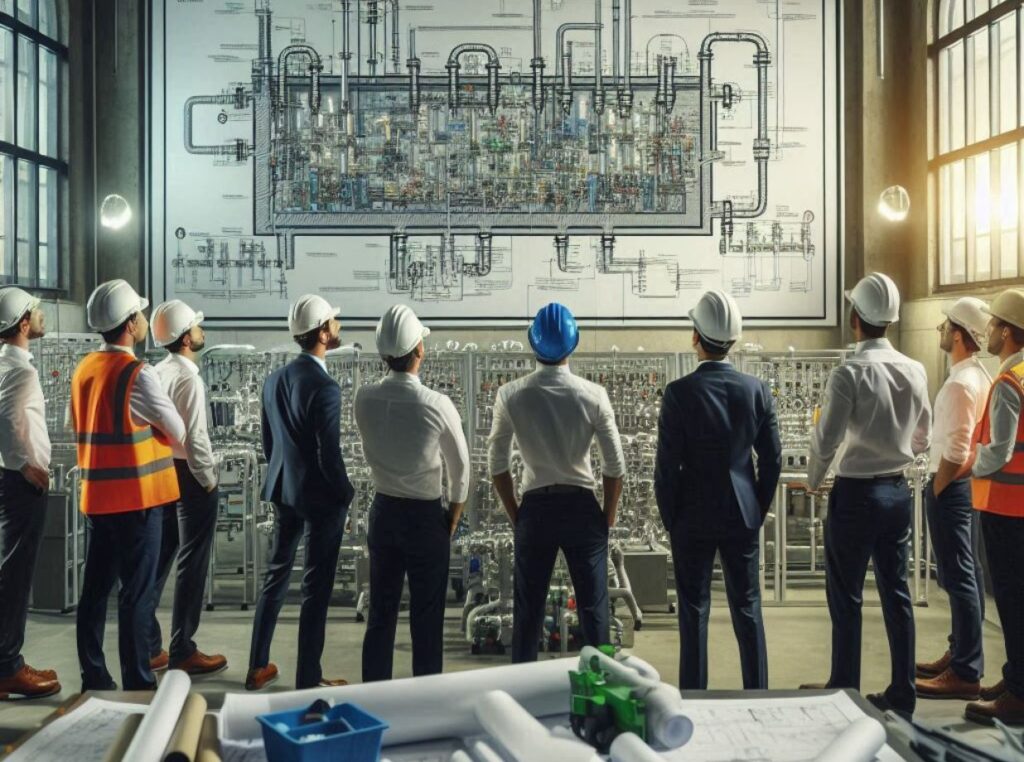Wastewater treatment is an essential process for ensuring clean and safe water. One critical component in this process is flow equalization. But what exactly does flow equalization do, and why is it so important in wastewater treatment systems?
Flow equalization helps manage the variations in wastewater flow, ensuring that treatment plants operate efficiently and effectively. This article explores the importance of flow equalization, its benefits, and best practices for implementing these systems.
Understanding Flow Equalization
Flow equalization is the practice of stabilizing the flow rate of wastewater before it enters the treatment process. This involves collecting and storing wastewater in a holding basin or tank and then releasing it at a controlled rate. This method is particularly useful for handling fluctuations in wastewater flow due to factors like varying daily water usage or storm events.
The Basics of Flow Equalization
Flow equalization is a fundamental concept in wastewater management. It involves the temporary storage of wastewater to regulate the flow into treatment plants. By leveling out the inflow, treatment facilities can function more smoothly, avoiding the peaks and troughs that can disrupt processes and lead to inefficiencies.
The Role of Storage Basins and Tanks
Storage basins and tanks are central to the flow equalization process. These structures are designed to hold excess water during peak flow times and gradually release it into the treatment system. This controlled release helps maintain a steady flow, which is crucial for effective treatment and resource management.
Addressing Daily and Seasonal Variations
Wastewater flow can vary significantly based on daily usage patterns and seasonal changes. For instance, residential areas may experience higher water usage in the mornings and evenings. Similarly, tourist destinations might see increased water demand during peak seasons. Flow equalization systems are essential to accommodate these variations, ensuring consistent treatment quality.
Hydraulic Surge Control Through Wastewater Flow Equalization
During heavy rainfall or peak usage times, wastewater plants can experience hydraulic surges. This can overwhelm the system and lead to inadequate treatment. Flow equalization tanks act as buffers, absorbing these surges and releasing the water gradually, thus preventing system overload.
Managing Storm-Related Surges
Storm events can lead to significant increases in wastewater flow, often exceeding the capacity of treatment facilities. Flow equalization tanks mitigate this by holding excess water and releasing it slowly, preventing the system from being overwhelmed.
Impact of Peak Usage on Treatment Systems
High usage periods, such as weekends or public holidays, can lead to spikes in wastewater flow. Without flow equalization, these peaks can stress treatment systems, resulting in suboptimal performance and potential regulatory breaches.
Protecting Infrastructure from Overload
Flow equalization not only stabilizes flow rates but also protects the physical infrastructure of treatment plants. By preventing sudden surges, the system avoids unnecessary wear and tear, extending the lifespan of critical components.

Benefits of Flow Equalization in Wastewater Treatment
Flow equalization provides numerous advantages for wastewater treatment systems. Here are some of the key benefits:
Improved Treatment Efficiency
By stabilizing the flow rate, flow equalization helps maintain consistent conditions for biological treatment processes. This consistency enhances the efficiency of removing contaminants and improves overall treatment performance.
Consistent Biological Process Conditions
Biological treatment processes rely heavily on stable environmental conditions to function effectively. Flow equalization ensures that the microorganisms responsible for breaking down pollutants are not subjected to sudden changes, which can disrupt their activity.
Enhanced Chemical Treatment Stability
Chemical treatments also benefit from flow equalization. By providing a steady flow, the mixing of chemicals and wastewater is optimized, leading to more effective contaminant removal and reduced chemical waste.
Reduction in Treatment Time
With a steady inflow of wastewater, treatment processes can be streamlined, potentially reducing the time required to achieve desired water quality. This efficiency can result in faster processing and increased overall plant capacity.
Cost Reduction
Wastewater flow equalization can significantly reduce treatment costs. By preventing the need for oversized equipment to handle peak flows, treatment plants can operate with more compact, cost-effective systems.
Avoidance of Oversized Infrastructure
Without equalization, treatment plants might need to invest in larger, more expensive equipment to accommodate peak flows. Flow equalization enables the use of smaller, more efficient systems, lowering capital and operational costs.
Energy Savings
A stable flow rate leads to more predictable energy usage, allowing treatment plants to optimize their energy consumption. This can result in significant cost savings, particularly for energy-intensive processes.
Reduced Maintenance Expenses
Consistent flow conditions reduce the strain on equipment, lowering the frequency and cost of maintenance. This can lead to longer equipment lifespans and reduced downtime for repairs.
Enhanced Effluent Quality
Flow equalization ensures that wastewater is treated under optimal conditions, leading to higher quality effluent. This is crucial for meeting regulatory standards and protecting the environment.
Meeting Stringent Regulatory Standards
Regulatory bodies often set strict limits on the quality of treated effluent. Flow equalization helps treatment plants consistently meet these standards by ensuring that processes operate under ideal conditions.
Protecting Aquatic Ecosystems
High-quality effluent is essential for protecting aquatic ecosystems. By reducing pollutants and ensuring consistent treatment, flow equalization minimizes the environmental impact of wastewater discharge.
Public Health Benefits
Improved effluent quality also has direct public health benefits. By reducing contaminants in discharged water, flow equalization helps protect communities from waterborne diseases and pollutants.
Stormwater Management
In stormwater management, flow equalization plays a vital role by mitigating the impact of sudden influxes of rainwater. This helps prevent flooding and reduces the strain on municipal sewage systems.
Flood Prevention Measures
Flow equalization systems are an integral part of flood management strategies. By controlling the release of stormwater, these systems help prevent urban flooding and protect infrastructure.
Reducing Urban Runoff
Urban areas often struggle with runoff during heavy rainfall. Flow equalization tanks can store excess water, reducing the immediate impact on sewage systems and preventing overflows.
Alleviating Pressure on Municipal Systems
By managing stormwater flows, equalization systems ease the burden on municipal sewage systems. This can prevent system overloads and ensure that treatment plants operate effectively during peak events.
Best Practices for Wastewater Flow Equalization
Implementing flow equalization effectively requires careful planning and design. Here are some best practices to consider:
Design Considerations for Wastewater Flow Equalization Basins
When designing flow equalization basins, it is crucial to consider factors such as basin size, inflow and outflow rates, and the type of materials used. The design should accommodate peak flows while minimizing the risk of overflows.
Sizing and Capacity Planning
Accurate sizing of equalization basins is essential. Engineers must consider historical flow data, peak usage scenarios, and future growth projections to ensure that basins can handle expected volumes.
Material Selection and Construction
The choice of materials for constructing equalization basins impacts their durability and effectiveness. Engineers should select materials resistant to corrosion and chemical exposure to ensure long-term functionality.
Incorporating Safety Features
Designs should include safety features like overflow channels and alarms to prevent accidental spills. These features help protect the surrounding environment and ensure compliance with safety regulations.
Optimizing Wastewater Flow Management with Equalization Tanks
To optimize flow management, it is essential to integrate flow equalization tanks with other components of the treatment system. This includes using sensors and control systems to monitor and adjust flow rates in real-time.
Integration with Control Systems
Advanced control systems can enhance flow equalization by providing real-time data on flow rates and system performance. This allows for dynamic adjustments to optimize treatment efficiency.
Use of Automation and Monitoring Technologies
Automation technologies can streamline the management of flow equalization systems. Sensors and automated valves can adjust flow rates based on real-time data, improving responsiveness and accuracy.
Coordinating with Other Treatment Processes
Flow equalization should be coordinated with other treatment processes to maximize overall plant efficiency. This requires a holistic approach to system design and management.
Maintenance and Monitoring
Regular maintenance and monitoring of flow equalization systems are vital for ensuring their long-term effectiveness. This involves routine inspections, cleaning, and adjustments to control settings as needed.
Establishing Maintenance Schedules
A proactive maintenance schedule helps ensure that equalization systems remain in optimal condition. Regular inspections can identify potential issues before they lead to system failures.
Conducting Routine Inspections
Routine inspections are crucial for identifying wear and tear, blockages, and other issues. Early detection allows for timely repairs, minimizing disruptions and maintaining system integrity.
Monitoring System Performance
Continuous monitoring of system performance is essential for identifying trends and anomalies. Data collected from monitoring can inform maintenance decisions and system upgrades.
How Wastewater Flow Equalization Tanks Help Manage Peak Flows
Flow equalization tanks are designed to handle peak flow events by temporarily storing excess wastewater. During periods of low flow, the stored wastewater is gradually released back into the treatment process. This helps maintain a consistent flow rate, reducing the risk of system overload.
Balancing Inflow and Outflow
Flow equalization tanks balance the inflow and outflow of wastewater, ensuring that treatment plants operate within their capacity. By smoothing out fluctuations, these tanks prevent overloads and optimize system performance.
Preventing System Overloads
System overloads can lead to treatment failures and regulatory breaches. Flow equalization tanks provide a buffer against these events, protecting both the treatment process and the environment.
Enhancing Treatment Plant Resilience
By managing peak flows, flow equalization tanks enhance the resilience of treatment plants. This allows them to adapt to changing conditions and maintain consistent performance.

Peak Flow Reduction Techniques Using Wastewater Equalization Systems
Several techniques can be used in conjunction with flow equalization systems to reduce peak flows:
Flow Rate Normalization Strategies
Flow rate normalization involves adjusting the release of stored wastewater to match the treatment plant’s capacity. This can be achieved through automated control systems that respond to real-time data.
Adaptive Release Mechanisms
Adaptive release mechanisms adjust the flow rate based on current treatment capacity and conditions. This ensures that the system operates efficiently, even during peak events.
Real-Time Data Utilization
Utilizing real-time data allows for more accurate flow adjustments. This data-driven approach ensures that flow rates are optimized for current conditions, enhancing treatment efficiency.
Dynamic Flow Control
Dynamic flow control systems can respond to changing conditions in real time, adjusting flow rates to prevent overloads and maximize treatment efficiency.
Diversion Systems
In some cases, diversion systems can be used to redirect excess flow to secondary treatment facilities or storage areas. This provides additional flexibility in managing peak flow events.
Secondary Treatment Options
Diversion systems can direct excess flow to secondary treatment facilities, ensuring that all wastewater receives adequate treatment. This approach enhances overall system capacity and resilience.
Emergency Overflow Paths
Emergency overflow paths provide a safety net during extreme peak events. By redirecting excess flow, these paths protect primary treatment systems from overloads.
Strategic Flow Redirection
Strategic redirection of flow can optimize system performance and prevent overloads. By balancing loads across multiple facilities, treatment plants can maintain efficiency and effectiveness.
Wastewater Flow Equalization and Its Impact on Effluent Quality
The quality of treated effluent is a critical concern for wastewater treatment plants. Flow equalization directly impacts effluent quality by ensuring consistent treatment conditions. This leads to more reliable removal of contaminants and better compliance with environmental regulations.
Consistency in Treatment Conditions
Consistent treatment conditions are vital for maintaining effluent quality. Flow equalization ensures that treatment processes operate under stable conditions, improving contaminant removal and water quality.
Reliability in Contaminant Removal
Flow equalization enhances the reliability of contaminant removal processes. By providing stable conditions, treatment systems can function at peak efficiency, ensuring effective pollutant reduction.
Meeting Environmental Regulations
Environmental regulations set strict standards for effluent quality. Flow equalization helps treatment plants consistently meet these standards, protecting the environment and avoiding regulatory penalties.
Advantages of Installing Flow Equalization Tanks in Wastewater Treatment Systems
Installing flow equalization tanks provides several advantages for wastewater treatment systems:
- Stabilization of Treatment Processes: By normalizing flow rates, equalization tanks help stabilize biological and chemical processes, improving overall treatment efficiency.
- Increased Plant Capacity: Flow equalization allows treatment plants to handle higher volumes of wastewater without needing additional infrastructure.
- Reduced Risk of System Overload: By buffering hydraulic surges, equalization tanks prevent system overloads that can lead to treatment failures.
Enhancing Process Stability
Flow equalization stabilizes treatment processes by maintaining consistent flow rates. This stability enhances the efficiency and effectiveness of both biological and chemical treatments.
Expanding Treatment Capacity
By managing peak flows, flow equalization tanks increase the capacity of treatment plants. This allows facilities to handle larger volumes of wastewater without costly infrastructure expansions.
Minimizing Overload Risks
Flow equalization tanks minimize the risk of system overloads by buffering against hydraulic surges. This protection enhances system resilience and prevents treatment failures.
Conclusion
Flow equalization is a vital component of modern wastewater treatment systems. By managing fluctuations in flow rates, it enhances treatment efficiency, reduces costs, and improves effluent quality. Implementing best practices in flow equalization can significantly benefit municipal sewage plants and stormwater management systems, ensuring they operate effectively and sustainably.
As the demand for efficient wastewater treatment grows, investing in flow equalization systems becomes increasingly important for environmental protection and public health. By stabilizing flow rates and optimizing treatment processes, flow equalization systems play a crucial role in sustainable water management, safeguarding communities and ecosystems alike.
